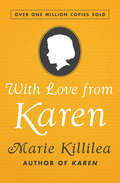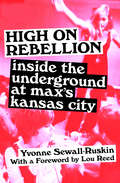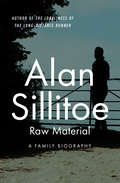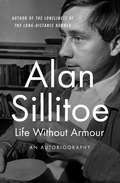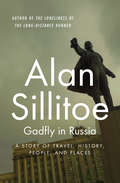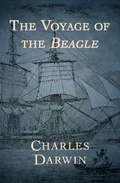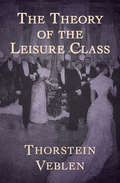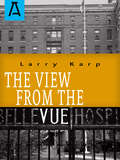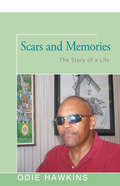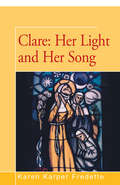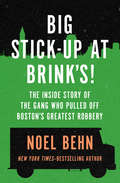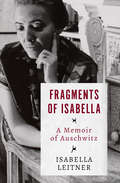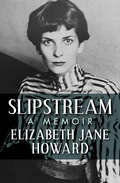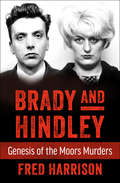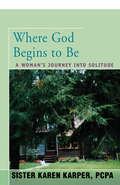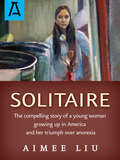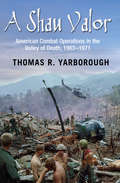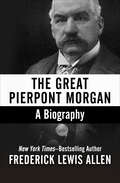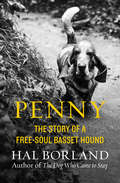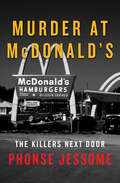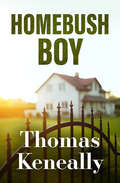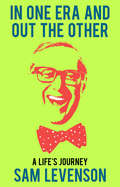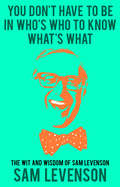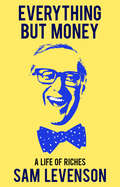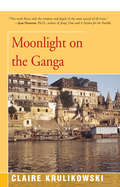- Table View
- List View
With Love from Karen
by Marie KillileaThe Killilea family returns in the heartwarming sequel to national bestseller KarenWith Love from Karen picks up five years after the conclusion of Karen, the miraculous and true story of a girl with cerebral palsy who triumphed against all odds. It follows the Killileas through Karen's teen years and into adulthood. Karen and her family continue to face seemingly insurmountable obstacles: They must fight for Karen's right to attend public school, support Karen in her dream to raise and exhibit champion show dogs, and encourage her in her decision to use a wheelchair or walk on her own. Once again, the Killilea family proves that the power of faith, love, and courage in the face of adversity can make miracles happen.
High on Rebellion: Inside the Underground at Max's Kansas City
by Yvonne Sewall-RuskinWith a foreword by Lou Reed: The definitive oral history of Max's Kansas City, favorite hangout of the most outrageous and notorious characters of New York's 1960s and '70s underground cultural scene From its opening in December 1965 on Park Avenue South, Max's Kansas City, a hybrid restaurant, bar, nightclub, and art gallery, was the boisterous meeting spot for famous--or soon-to-be-famous--figures in New York's underground art, music, literary, film, and fashion scenes. Max's regulars included Andy Warhol (and his superstars such as Viva, Ultra Violet, Edie Sedgwick, Gerard Malanga, Holly Woodlawn, and Candy Darling), Mick Jagger, Lou Reed, Patti Smith, Allen Ginsberg, William Burroughs, David Bowie, Iggy Pop, Bob Dylan, Jane Fonda, and dozens more. A hotbed of drugs, sex, and creative collaboration, Max's was the place to see and be seen among the city's cultural elite for nearly two decades. With reminiscences from the likes of Alice Cooper, Bebe Buell, Betsey Johnson, Leee Black Childers, Holly Woodlawn, and John Chamberlain, along with Max's owner Mickey Ruskin and several waitresses and bartenders, this vivid oral history evokes an unforgettable place where a spontaneous striptease, a brawl over the meaning of art, and an early performance by the Velvet Underground were all possibilities on any given night. High on Rebellion dazzles with rare photos and other Max's memorabilia, and firsthand accounts of legendary nights, chance encounters, romances sparked and extinguished, and stars being born.
Raw Material: A Family Biography
by Alan SillitoeThis fusion of novel and memoir from a bestselling British author chronicles the destructive effects of WWI on two working-class families in Nottingham. An advocate for ordinary people, Alan Sillitoe combines family memoir with exhaustive research on military records, and fuses them with artistic speculation in this inventive and political historical novel. Central to the story are the author's grandfather, the blacksmith Ernest Burton, and his uncle Edgar, a World War I deserter. The launching point for this narrative family album is a legless match-seller from Sillitoe's childhood who "walked" on the streets of Nottingham with his hands. When the young Sillitoe asked his family about the reasons behind this man's deformity, he heard a series of different accounts: His mother said it was a train accident, his father claimed it was an explosion during the Battle of the Somme, his grandmother was convinced it was a birth defect, and his grandfather declared it was a way of dodging work. Thus Sillitoe sets the tone for a tale in which "anything which is not scientific or mathematical thought is colored by the human imagination and feeble opinion." In order to rediscover the fictional truth behind his own spirit, Sillitoe then delves into his heritage. He paints a telling portrait of his maternal grandfather, a blacksmith who hated dogs, despised the people who loved him, and was blinded in one eye by a shred of steel. Separated from society by his illiteracy, and both feared and respected for his instinctual cunning, Ernest was a tyrant to his wife and eight children, a hardworking provider, and a talented craftsman. On his father's side of the family, Sillitoe explores the life of his uncle Edgar, "the darling of the family" who enlisted in the British army when the Great War began in 1914. However, when the young man discovered that his service consisted of dysentery, haircuts, and taking orders, he "sensibly" deserts. To avoid the military police, he leaves Nottingham and bicycles furiously on the back roads to his sister's house in Hinkley, but is caught a few days later in a pub and sent back to his battalion. A persistent man, Edgar deserts a second time and hides out in the forest, but again he is captured and sent just in time to join the Sherwood Foresters on the first day of the Battle of the Somme. Raw Material spans a century of family history and legends, interweaving personal memories with collected facts and hearsay. The "kitchen-sink realism" Sillitoe is known for takes on a more philosophical and transparent approach in this innovative self-portrait that explores the base matter and inspirations of the esteemed British novelist's life work.
Life Without Armour: An Autobiography
by Alan SillitoeA candid and surprising memoir of the early life of one of England's most acclaimed and enduring post-WWII writers. Born in 1928 into a poverty-stricken family in working-class Nottingham, bestselling British novelist Alan Sillitoe's childhood was marked by his father's unpredictable and violent rage, as well as a near-certain condemnation to a life of labor on an assembly line. His family relocated frequently to avoid rent collectors, trading in one bug-infested hovel for another. Though intelligent and curious, the young author-to-be failed his grammar school entrance exams, and it seemed he was destined for work in a factory. The onset of Sillitoe's teenage years, however, coincided with the advance of Hitler into Russia, and the war offered a chance for the boy to seek out a different fate. At the age of fourteen, Sillitoe used a fake ID to enroll in the Air Training Corps and went on to join the Ministry of Aircraft Production as an air traffic control assistant. He dreamed of becoming a pilot, but the war ended just after he qualified for training and he was instead shipped off to the Malayan jungle during the Communist insurgency as a radio operator for the Royal Air Force (RAF). After two years of living from one wireless watch to the next--taking in bearings and atmospherics though the radio, and exploring dangerous and primal landscapes by foot--Sillitoe finally returned to a prospectless postwar England and was diagnosed with tuberculosis. But this curse soon became a blessing: In the RAF hospital, Sillitoe began to read--everything from Kant to Descartes to Bernard Shaw--and he decided to become a writer. Already a veteran on an RAF disability pension at the age of twenty-one, Sillitoe began writing full-time, neither his physical challenges nor his numerous rejections from publishers deterring him in the least. He joined the Nottingham Writers' Club, and his short stories began to achieve some minor local success. Soon after, a chance meeting with the American poet Ruth Fainlight led to full-blown love, and the two set off for France eager to live in a bucolic setting where they could dedicate all of their time to writing. Circumstance and favorable exchange rates then led the couple to Spain where Sillitoe continued his literary pursuits, met many artists and writers, had run-ins with gypsies, and even underwent police interrogations. Four unpublished novels later--and after nearly a decade of honing his craft--Sillitoe finally found staggering success in his working-class novel Saturday Night and Sunday Morning and his collection of short stories The Loneliness of the Long-Distance Runner. Written with Sillitoe's signature simplicity, this in-depth autobiography not only gives insight into the formative years and mental maturation of one of Britain's most influential writers, but also tells a great story of an underprivileged man who, with perseverance, made the most of his particular fate.
Gadfly in Russia: A Story of Travel, History, People, and Places
by Alan SillitoeThis memoir and literary travelogue from one of the UK&’s most esteemed novelists offers rare insight into Cold War–era Russia. In 1967, seeking an escape from his writing life, bestselling British novelist Alan Sillitoe embarks on a road trip from England to Russia via Harwich and Finland in his sturdy Peugeot. During his teens, the author had a cartographic fascination with the Battle of Stalingrad, and decades later he is still armed with intricate maps of the country based on British military intelligence, including one of the road from Leningrad to Moscow to Kiev, which he drew himself. Also in tow are a prismatic compass, binoculars, and a shortwave radio receiver. However, despite being so well prepared, Sillitoe embarks with naiveté about the political precariousness of an Englishman in the eyes of the Soviet regime. After passing through the endless days of a Scandinavian summer and a prolonged stop at a border control checkpoint—with his maps hidden in a secret compartment of the car—Sillitoe arrives in Leningrad. There, he meets George Andjaparidze, a worldly and candid English student who has been assigned by the Writers&’ Union to serve as the author&’s guide and keep him out of trouble. Though Sillitoe would rather continue his journey solo, Andjaparidze grows on him, and they begin what will become a lasting friendship. As soon as the duo leaves Leningrad, adventures and misadventures ensue. En route to Moscow, Sillitoe and Andjaparidze end up racing a pack of middle-age men in German sports cars partaking in a Berlin-to-Moscow rally. Sillitoe and Andjaparidze&’s time in the capital is equally fast-paced, consisting of late nights fueled by vodka, impounded rubles, caviar breakfasts, erudite parties, and a pat on the back from a traffic cop for writing about the working class. A winding drive across western Russia and into Yugoslavia follows, replete with rebellious literature students, a speech on freedom, a visit to Tolstoy&’s estate, accusations of espionage, and a near-fatal run-in with a brigade of Red Army tanks. At last the writer and guide reach their destination: Kursk, that fateful place where a Soviet victory in 1943 turned back the Nazi tide. But the story continues long after the road trip ends. Back in England, Andjaparidze visits Sillitoe and the two are caught up in a controversy surrounding the defection of the Soviet writer Anatoly Kuznetsov. Written from the perspective of another trip to Russia forty years later (Sillitoe was invited in 2005 by the British Council to return to Moscow), this travelogue provides a rare and intimate look at the country&’s history, a compassionate understanding of its troubled ideology, and a frank portrayal of its undeniable lure.
The Voyage of the Beagle: Journal Of Researches Into The Natural History And Geology Of The Countries Visited During The Voyage Of H. M. S. Beagle Round The World
by Charles DarwinThe riveting firsthand account of the historic voyage that led to the theory of evolution When the HMS Beagle set sail in 1831, the science of biology was not far removed from the Dark Ages. When the ship returned to England nearly five years later, Charles Darwin had the makings of a theory that would revolutionize our understanding of the natural world. From volcanoes in the Galapagos to the coral reefs of Australia, The Voyage of the Beagle documents the young naturalist's encounters with some of the earth's most stunning features. Darwin's observations of the people, places, and events he experienced make for compelling reading and offer a fascinating window into the intellectual development of his ideas about natural selection. A brilliant travelogue and a revealing glimpse into the Victorian mindset, The Voyage of the Beagle is an indispensable companion volume to On the Origin of Species. This ebook has been professionally proofread to ensure accuracy and readability on all devices.
The Theory of the Leisure Class
by Thorstein VeblenThis scathing critique of America’s preoccupation with wealth and status in the Gilded Age continues to resonate more than a century after it was first published According to economist Thorstein Veblen, the leisure class produces nothing, contributes nothing, and creates nothing, yet exercises a peculiar control over American society. The shallowness of their interests—from fashion to sports to entertainment—endows the practice of “conspicuous consumption” with an undeserving air of respectability. Veblen deploys a razor sharp wit to expose the pretensions of the idle rich and their disastrous influence on the national character. From ruthless business practices to the plight of women in a male-dominated culture, The Theory of the Leisure Class tackles difficult subjects with sophisticated analysis and a vibrant literary style that influenced the work of authors including Edith Wharton, Henry James, and F. Scott Fitzgerald. A must-read for students of American history and anyone concerned about economic inequality, Veblen’s classic treatise is timelier today than ever. This ebook has been professionally proofread to ensure accuracy and readability on all devices.
The View from the Vue
by Larry Karp"We called it THE VUE, and without a doubt, that was the most complimentary nickname Bellevue Hospital ever had. " So begins The View from the Vue, an "entertaining, colorful recall" (Publishers Weekly) of life a half-century ago at New York City's medical court of last resort. Between 1959 and 1965, Dr. Larry Karp served as medical student, intern, and resident physician at Bellevue. During these six years, he came to know and understand the people who wended their way through the dingy hallways and roach-infested subterranean passages, and inhabited the sparsely furnished wards of the fabulous hospital whose origins date back to 1811. It's not surprising that Dr. Karp has never been able to forget The Vue. Writing in a style both human and humorous, he recalls some of the astonishingly funny and dramatic events he lived through, involving bizarre patients and grotesque working conditions. In the process, he gives us a clear picture of what it was like at Bellevue in the early sixties . . . for both doctors and patients.
Scars and Memories: The Story of a Life
by Odie HawkinsThe deeply personal story of Odie Hawkins's journey, from "the poorest of the poor" childhood in Chicago to Hollywood screenwriter--and the people who deeply mattered. A tough, touching autobiography.
Clare: Her Light and Her Song
by Karen FredetteClare: Her Light and Her Song is a vivid portrait of a strong woman who scandalizes family and friends to follow her beloved mentor, Francis of Assisi, in a life of joyous poverty. Thoroughly researched, this biography faithfully depicts Clare as seen by her contemporaries, including cardinals and popes. Her story is enriched by accounts of the wars, political intrigues, and towering figures of the tumultuous thirteenth century in which she played a significant role. The first woman to receive Papal approval for her own Rule of Life, Clare continues as a model for women of the twenty-first century.
Big Stick-Up at Brink's!: The Inside Story of the Gang Who Pulled Off Boston's Greatest Robbery
by Noel BehnA riveting and frequently hilarious insider account of one of the twentieth century's most outrageous capers. On the evening of January 17, 1950, armed robbers wearing Captain Marvel masks entered the Brink's Armored Car building in Boston, Massachusetts. They walked out less than an hour later with more than $2.7 million in cash and securities. It was a brazen and expertly executed theft that captured the imaginations of millions of Americans and baffled the FBI and local law enforcement officials. But what appeared on the surface to be the perfect crime was, in fact, the end result of a mind-boggling series of mistakes, miscalculations, and missteps. The men behind the masks were not expert bank robbers but a motley crew of small-time crooks who bumbled their way into a record-breaking payday and managed to elude the long arm of the law for six years. New York Times-bestselling author Noel Behn tape-recorded nearly one thousand hours of interviews with the surviving robbers, including motormouthed mastermind Tony Pino, a character so colorful he might have been dreamed up by a Hollywood screenwriter, to tell the uncensored story of the heist forever known as "the Great Brink's Robbery." Fun and suspenseful from first page to last, Behn's true-crime classic was the basis for The Brink's Job (1978), the Academy Award-nominated film directed by William Friedkin and starring Peter Falk and Peter Boyle.
Fragments of Isabella: A Memoir of Auschwitz
by Isabella LeitnerThe deeply moving true account of a young Jewish woman's imprisonment by the Nazis at the Auschwitz death camp. On May 29, 1944, the day after Isabella Katz's twenty-third birthday, she, her family, and all the Jews in the ghetto in Kisvárda, Hungary, were rounded up by Nazi storm troopers, packed into cattle cars, and deported to Auschwitz. There, Dr. Josef Mengele, the so-called Angel of Death, scrutinized the family and decided who would live--for a time--and who would die. Isabella and three of her sisters waged a daily battle to survive, giving one another strength, courage, and love, promising themselves that they would cheat the crematoriums and end each day alive. Thirty years after she escaped from the Nazis, Isabella wrote this powerful and luminous memoir. Hailed by Publishers Weekly as "a celebration of the strength of the human spirit as it passes through fire," Fragments of Isabella has become a classic of holocaust literature and human survival.This ebook features rare images from the author's estate.
Slipstream: A Memoir
by Elizabeth Jane HowardThe intimate and revealing memoir of the woman behind the bestselling Cazalet Chronicles and a fascinating window into the British literary world. One of Britain's most famous and beloved authors, Elizabeth Jane Howard's life was as rich, varied, and passionate as the characters in her novels. In her brutally honest, at times humorous, wholly captivating autobiography, the woman who felt she lived "in the slipstream of experience" employs her prodigious skills as a novelist to chart the course of an eventful life--including three marriages, multiple affairs, and friendships with the literary giants of the day, among them Kenneth Tynan and Cecil Day-Lewis. Born in 1923 to bohemian parents within a large Edwardian family, Howard was raised in privilege and security. Educated at home from the age of eleven, she enjoyed short-lived careers as a model, an actress, and an editor before she found her métier as a novelist. She gained invaluable experience growing up in a time bookended by two world wars and enjoyed a level of independence denied an earlier generation of British women. In her memoir, Howard writes with painful candor about her introduction to sex--her father abused her when she was fifteen--and her marriage to Peter Scott, son of the famed British explorer, along with her tempestuous third marriage to Kingsley Amis. She delves into complicated romantic and family relationships, inviting the reader to accompany her on her search for truth in life. Featuring cameos by William Faulkner, Rosamond Lehmann, Evelyn Waugh, Charlie Chaplin, Paul Scofield, and many others, Slipstream finally illuminates a struggle common to women writers of every time and place: carving out a room of one's own.
Brady and Hindley: Genesis of the Moors Murders
by Fred HarrisonThe shocking true crime story of child murderers Ian Brady and Myra Hindley, Great Britain's most horrific serial killers. During the early 1960s, just as Beatlemania was exploding throughout the United Kingdom, a pair of psychopathic British killers began preying on the very young, innocent, and helpless of Greater Manchester. Between 1963 and 1965, Ian Brady and his lover and partner, Myra Hindley, were responsible for the abduction, rape, torture, and murder of five young victims, ranging in age from ten to seventeen years old. The English press dubbed the grisly series of homicides "the Moors Murders," named for the desolate landscape where three of the corpses were eventually discovered. Based in part on the author's face-to-face prison interviews with the killers, Fred Harrison's fascinating and disturbing true crime masterwork digs deeply into Brady and Hindley's personal histories to examine the factors that led to their mutual attraction and their evolution into the UK's most notorious pair of human monsters. It was during these interviews that new details about the killers' terrible crimes surfaced, compelling the police to reopen what was arguably the most shocking and sensational homicide case in the annuls of twentieth-century British crime. With a new introduction by the author, meticulously researched and compellingly written, Brady and Hindley is the definitive account of Britain's most hated serial killers.
Where God Begins to Be: A Woman's Journey into Solitude
by Karen Fredette"In her inspiring, vividly composed and always faithful book" (Susan Muto), Karen Fredette describes a world where life is rich in being rather than in having. Selected as a Catholic Book of the Month, Where God Begins to Be fulfills Murray Bodo's observation that "instead of myth fabricated from a few fragments, we have here the details--the nitty-gritty, muddy details--of a hermit's daily living." Karen is a "Seer who brings you along with her, joyfully" (Richard Rohr). "In deftly drawn vignettes, Karper's story, told with simplicity and gentle honesty, is one of faith deepening, beauty awakening, and love discovered" (Gerald May).
Solitaire
by Aimee LiuSolitaire is the groundbreaking memoir of a young woman growing up in the 1970s and her triumph over anorexia nervosa.
A Shau Valor: American Combat Operations in the Valley of Death, 1963–1971
by Thomas R. YarboroughFrom the award-winning author of Da Nang Diary, the "detailed military history" (Publishers Weekly) of the fighting between the North Vietnamese Army and the US military and its South Vietnamese allies in the "Valley of Death," site of the infamous Battle of Hamburger Hill Throughout the Vietnam War, one focal point persisted where the Viet Cong guerrillas and Army of the Republic of Viet Nam (ARVN) were not a major factor, but where the trained professionals of the North Vietnamese and US armies repeatedly fought head-to-head. A Shau Valor is a thorough study of nine years of American combat operations encompassing the crucial frontier valley and a fifteen-mile radius around it-the most deadly killing ground of the entire war. Beginning in 1963, Special Forces A-teams established camps along the valley floor, followed by a number of top-secret Project Delta reconnaissance missions through 1967. Then, US Army and Marine Corps maneuver battalions engaged in a series of sometimes-controversial thrusts into the A Shau, designed to disrupt NVA infiltrations and to kill enemy soldiers, part of what came to be known as Westmoreland's "war of attrition." The various campaigns included Operation Pirous (1967); Operations Delaware and Somerset Plain (1968); and Operations Dewey Canyon, Massachusetts Striker, and Apache Snow (1969)-which included the infamous battle for Hamburger Hill-culminating with Operation Texas Star and the vicious fight for and humiliating evacuation of Fire Support Base Ripcord in the summer of 1970, the last major US battle of the war. By 1971, the fighting had once again shifted to the realm of small Special Forces reconnaissance teams assigned to the ultra-secret Studies and Observations Group (SOG). Other works have focused on individual battles or units, but A Shau Valor is the first to study the campaign-for all its courage and sacrifice-chronologically and within the context of other historical, political, and cultural events.
The Great Pierpont Morgan: A Biography
by Frederick Lewis AllenA revealing biography of J. P. Morgan, one of the most powerful and enigmatic financiers in history, from bestselling author Frederick Lewis Allen. Celebrated as a titan of industry by some and decried as a monopolizing robber baron by others, John Pierpont Morgan was without a doubt a dominant player in American finance at the turn of the twentieth century. He founded U.S. Steel, a conglomeration of leading steel and iron producers, which was the nation's largest coast-to-coast railroad system, and the first company to be worth more than $1 billion. Morgan was also instrumental in developing the Federal Reserve after working with political leaders to prevent a potentially devastating fiscal crisis in 1907. Indeed, he was a driving force in the modernization of American business, and the effects of his acumen and foresight continue to resonate today--on Wall Street and beyond. Additionally, known for his displays of wealth and power, Morgan was a prominent figure of the New York society scene--a member of the original one percent--as well as a notable art connoisseur with a sizable collection now housed in Manhattan's lavish Morgan Library & Museum, once his own private library. In this meticulously researched and comprehensive biography, Frederick Lewis Allen, former editor of Harper's magazine and author of Only Yesterday, delves into the life and character of a fascinating, multidimensional man. Allen also probes the evolution of the business landscape during Morgan's lifetime, when giant corporations with unparalleled economies of scale began to absorb and replace smaller competitors. This richly detailed portrait of a man whose name is inseparable from American finance is essential reading for anyone seeking a deeper understanding of banking and business history.
Penny: The Story of a Free-Soul Basset Hound
by Hal Borland"Some dogs, like some people, just can't abide a quiet life," writes Hal Borland, author of The Dog Who Came to Stay, in this warm and touching memoir. Penny the basset shows up at the Borlands' Connecticut farmhouse on a cold, snowy day--head held high, tail wagging, as if she were a long-awaited guest. Hal and Barbara Borland were no strangers to strays. Pat, the rabbit hound thousands of readers came to know in The Dog Who Came to Stay, had also appeared one winter, staying to become the family's dear companion. Now, Pat is gone, and Hal and Barbara are bereft without canine company. They fall in love with Penny--and she seems to fit right in. Penny is a delightful dog--short-legged, flop-eared, full of fun and curiosity. And she loves people, so much so that she leaves the Borlands to go visiting elsewhere, often settling in with a different family for days on end. Indeed, Hal and Barbara admire her for her spirit of individuality and independence. Though she never truly belonged to them, the Borlands agreed that Penny was a dog well worth loving--and so will readers.
Murder at McDonald's: The Killers Next Door
by Phonse JessomeThe chilling true crime account of the botched robbery that would become the most sensational murder case in Canadian history: the Sydney River McDonald's massacre. It started with a broken conveyor belt. When the mechanical malfunction brought eighteen-year-old McDonald's employee Derek Wood into the restaurant's back room, he saw the safe and got a dangerous idea. It would be so easy to prop the back door open, allowing two friends to sneak inside and steal the money. Wood assumed there was at least $200,000 in the cashbox--an incredible haul for just a few minutes' work--but things would not go according to plan. The robbery went wrong from the start, and within minutes, a fast-food restaurant in the wilds of Nova Scotia was turned into a bloodbath. Wood and his accomplices attacked the employees, killing three instantly and leaving the fourth for dead. In the safe, where they had expected to find a fortune, there was barely $2,000. They fled the scene, instigating a manhunt that would captivate the nation. In the tradition of In Cold Blood and The Onion Field, this stunning work of true crime tells the story of the small-town murder that shocked a nation. Phonse Jessome brings a trained journalist's eye to the case, which remains one of the most horrifying incidents of suburban violence in recent history.
Homebush Boy
by Thomas KeneallyIn this playful and poignant memoir, Thomas Keneally returns to his adolescence in the suburbs of Sydney in 1952. At sixteen, the red-haired teenager idolized the poetry of Gerard Manley Hopkins and had aspirations of becoming a star on the track or rugby field. He also dreamed of wooing the beautiful and alluring Bernadette Curran until the day she announces her desire to become a nun. For the first time, Keneally started to consider priesthood himself. An insightful portrait of the transition from childhood to adulthood, Homebush Boy affectionately captures the awkwardness, grace, and all the contradictions of being a teenager.
In One Era and Out the Other: A Life's Journey
by Sam LevensonThe beloved humorist and author Sam Levenson finds that some of his old worldviews don't fit the new one he now sees. Levenson's grew up the youngest of eight children in a large Jewish immigrant family in New York. He evolved from a Spanish teacher in Brooklyn to working the Catskills circuit as a comedian. By the 1950s, Levenson was a fixture in American homes as television personality, appearing and guest hosting numerous times on classic shows like This Is Show Business, Two For The Money, and The Ed Sullivan Show. For several years, he hosted his own variety show on CBS called The Sam Levenson Show, where the set doubled as a school classroom and where guests often evoked Levenson's love of learning, teaching and family. Through his lens, looking back on his life, we see how the world has transformed. His wit and humor make for timeless observations on money, technology, and life, that endeared Levenson to millions of Americans over the last 50 years.
You Don't Have to Be in Who's Who to Know What's What: The Choice Wit and Wisdom of Sam Levenson
by Sam LevensonThe author and humorist Sam Levenson is quoted hundreds of time each day on Twitter, and his sayings appear on everything from t-shirts to inspirational signs. To read through and savor You Don't Have To Be In Who's Who To Know What's What is to discover much of the source material for his timeless wisdom. It is a treasure trove of topics ranging from family ("Insanity is hereditary; you can get it from your children") to perseverance ("Don't watch the clock; do what it does. Keep going.") Levenson's upbringing was as the youngest of eight children in a large Jewish immigrant family in New York. He evolved from a Spanish teacher in Brooklyn to working the Catskills circuit as a comedian and by the 1950s was a fixture in American homes as television personality, appearing and guest hosting numerous times on classic shows like This Is Show Business, Two For The Money, and The Ed Sullivan Show. For several years, he hosted his own variety show on CBS called The Sam Levenson Show, where the set doubled as a school classroom and the guests often evoked Levenson's love of learning, teaching, and family. These experiences informed his lessons about life, family and careers, and make this definitive collections of his views and sayings so timeless.
Everything But Money: A Life of Riches
by Sam LevensonIn this timeless classic that topped the New York Times bestseller list in 1966 and 1967, Sam Levenson recalls his childhood with the warmth and affectionate humor that endeared the author and humorist to millions of Americans. He describes the cramped New York tenement which he shared with his parents, his six older brothers, and his sister as a "a life of plenty"--plenty of relatives, neighbors, boarders, janitors, hugs, slaps, books, music, weddings, illnesses, cats, dogs, cockroaches, and the like. He recalls how his parents bestowed upon him a "life of plenty"--plenty of hope, ambition, and faith in education, all of which became the hallmarks of his life and career. As he remembers his parents with overwhelming love, and cherishes the ethical values they instilled in him, he shows how those values are timeless and have helped him as he became a parent. His vivid recollections of a big family, rich in everything but money, are interspersed with a deep concern for the social and moral dilemmas facing today's young people, dilemmas which carry on to this day. Sam Levenson's blend of sweetness, hilarity and wisdom shines through Everything But Money and offers lessons that we can all learn from, lessons that are timeless and as relevant now as they were 50 years after Everything But Money was first released . . .
Moonlight on the Ganga
by Claire KrulikowskiIn this reflective and enjoyable India travel memoir, "hooks of fears" claw at author Claire Krulikowski on her first morning's awakening in India, a land she'd never planned to visit. However, in Rishikesh she hears the call of Ma Ganga, the sacred Ganges River, and accepts its enticing invitation to leave everything she knows behind. Diving into the river of life teeming around her, including meetings with lepers, wounded monkeys, swamis, stalkers, pilgrims, shopkeepers, holy cows, and more, Krulikowski steps outside her beliefs of how things "should be," trusting life and everything in it! She comes to know happiness and peace moment-by-moment. Presented in exquisite vignettes, enjoy these tales of spirit that are seemingly channeled by the sacred river.
